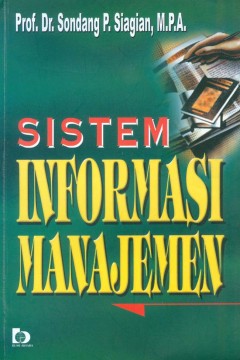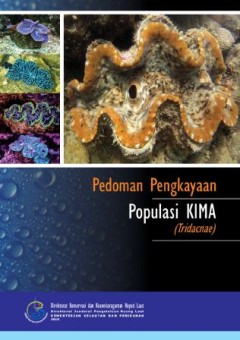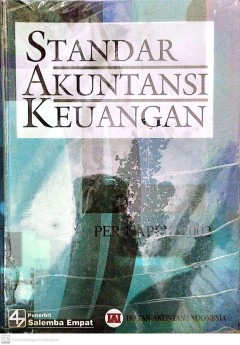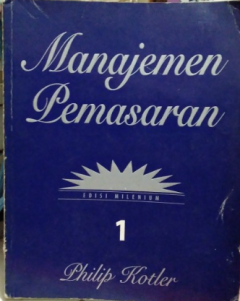Ditapis dengan

Pengantar public relations teori dan praktik
Pengantar Public Relation ini adalah panduan bagi anda untuk memahami dasar-dasar public relation, dari mana asalnya dan apa pengertiannya dan isu apa yang sedang terjadi.
- Edisi
- -
- ISBN/ISSN
- 9789797694357
- Deskripsi Fisik
- xx, 254 hlm.; 24 cm.
- Judul Seri
- -
- No. Panggil
- 659.2 KEI p

Effective Public Relations
Buku inilah yang memberikan bentuk awal public relation, dan ia pulalah yang mengembangkan wajah public relations sebagaimana terlihat sekarang : substantif, profesionaL....
- Edisi
- -
- ISBN/ISSN
- 979-3925-49-3
- Deskripsi Fisik
- xxiv, 548 hlm, 19 x 25 cm
- Judul Seri
- -
- No. Panggil
- 659.1 SCO e

Consumer Behavior & Marketing Strategy
Asosiasi pemasaran Amerika mendefinisikan perilaku konsumen sebagai interaksi dinamis dari pengaruh dan kognisi, perilaku dan lingkungan dimana manusia melakukan aspek pertukaran kehidupan mereka.
- Edisi
- Ed. 7
- ISBN/ISSN
- 0-07-286487-7
- Deskripsi Fisik
- xxv, 578 hal; 27 cm
- Judul Seri
- -
- No. Panggil
- 658.84 JPA c

Republic Relations
- Edisi
- Ed. 1
- ISBN/ISSN
- 9786029811797
- Deskripsi Fisik
- 16 x 23 cm; xx + 368 hlm.
- Judul Seri
- -
- No. Panggil
- 659.2 FIR r
- Edisi
- Ed. 1
- ISBN/ISSN
- 9786029811797
- Deskripsi Fisik
- 16 x 23 cm; xx + 368 hlm.
- Judul Seri
- -
- No. Panggil
- 659.2 FIR r

Manajemen Sumber Daya Manusia
Manajemen Sumber Daya Manusia sebagai suatu bidang studi yang khusus mempelajari peranan dan hubungan manusia dalam mencapai tujuan organisasi / perusahaan terus dikembangkan hingga sekarang. Dengan MSDM, pihak manajemen perusahaan akan dapat mengarahkan karyawan secara benar sehingga potensinya berkembang. Lebih lanjut tujuan organisasi/perusahaan akan lebih mudah tercapai. Jadi, tidak ada sal…
- Edisi
- Cet. 15
- ISBN/ISSN
- 979-526-491-5
- Deskripsi Fisik
- 23 x 15 cm; vii + 273 hlm.
- Judul Seri
- -
- No. Panggil
- 658.3 MAL m

Peranan Humas Dalam Perusahaan
Kehadiran buku ini dimaksudkan adalah untuk memberikan gambaran mengenai pentingnya peranan Humas atau public relations dalam suatu instansi, perusahaan atau pun lembaga; utamanya untuk menumbuhkan pendapat publik yang menguntungkan (favourable public opinion) dan seimbang, yaitu antara kepentingan perusahaan dengan kepentingan publik, di samping strategi membangun pencitraan lembaga (corporate…
- Edisi
- Cet. 1
- ISBN/ISSN
- 978-979-756-766-8
- Deskripsi Fisik
- 23 cm; xii + 216 hlm.
- Judul Seri
- -
- No. Panggil
- 659.285 DAN p

Periklanan: komunikasi pemasaran terpadu
- Edisi
- Ed. 1, Cet. 3
- ISBN/ISSN
- 9786028730181
- Deskripsi Fisik
- xii, 394 hlm.; 15 x 23 cm
- Judul Seri
- -
- No. Panggil
- 659.1 MOR p
- Edisi
- Ed. 1, Cet. 3
- ISBN/ISSN
- 9786028730181
- Deskripsi Fisik
- xii, 394 hlm.; 15 x 23 cm
- Judul Seri
- -
- No. Panggil
- 659.1 MOR p

Ilmu Hubungan Masyarakat Praktis
- Edisi
- -
- ISBN/ISSN
- -
- Deskripsi Fisik
- xiv, 273p., 21 cm
- Judul Seri
- -
- No. Panggil
- 659.2 BLA i
- Edisi
- -
- ISBN/ISSN
- -
- Deskripsi Fisik
- xiv, 273p., 21 cm
- Judul Seri
- -
- No. Panggil
- 659.2 BLA i

Manajemen Pemasaran Modern
Pasar (markets) adalah institusi yang memungkinkan terjadinya pertukaran melalui tawar menawar atau pelelangan. Institusi memungkinkan peran krusial dalam mengalokasikan sumber daya dan juga membantu menentukan distribusi pengaruh politik, sosial, dan intelektual.
- Edisi
- Cet 4
- ISBN/ISSN
- 978-979-26-8532-9
- Deskripsi Fisik
- 14.5 x 21 cm; 235 hlm.
- Judul Seri
- -
- No. Panggil
- 658.81 DEL m

IMC That Sells
Buku ini merupakan kristalisasi dari pengalaman selama 30 tahun menggeluti dunia komunikasi pemasaran yang ditulis oleh praktisi yang telah sukses membawa brand – brand Indonesia menjadi pemimpin pasar. Konsep integrated marketing communication (IMC) dalam buku ini dirumuskan secara holistic dan sistematis yang disebut the 3P : Philosophy, principles, practice. IMT that sells merupakan sekuel…
- Edisi
- Cet. 1
- ISBN/ISSN
- 978-979-22-7624-9
- Deskripsi Fisik
- 21,9 x 14,8 cm ; xxxvi + 310 hlm.
- Judul Seri
- -
- No. Panggil
- 658.802 ADJ i

Manajemen Public Relations : strategi menjadi humas profesional
- Edisi
- -
- ISBN/ISSN
- 978-979-1486-36-1
- Deskripsi Fisik
- xvii,364 hlm., 15 x 23 cm
- Judul Seri
- -
- No. Panggil
- 659.2 MOR m
- Edisi
- -
- ISBN/ISSN
- 978-979-1486-36-1
- Deskripsi Fisik
- xvii,364 hlm., 15 x 23 cm
- Judul Seri
- -
- No. Panggil
- 659.2 MOR m

Pengantar Akuntansi (Memahami Akuntansi Dasar)
Buku ini tersusun atas tujuh belas bab dengan judul Pengantar Akuntansi (Memahami Akuntansi Dasar). Setiap bab dibahas secara terperinci dengan subbab: Ruang Lingkup dan Sejarah Akuntansi; Persamaan Akuntansi dan Contohnya; Siklus Akuntansi Perusahaan Dagang; Siklus Akuntansi Perusahaan Jasa; Fungsi dan Sistem Akuntansi; Bukti Transaksi; Tahapan Pencatatan Transaksi Keuangan; Jurnal Umum dan Ju…
- Edisi
- Ed. 1, Cet. 1
- ISBN/ISSN
- 978-623-195-415-2
- Deskripsi Fisik
- vi + 251 hlm.; 15.5 x 23 cm
- Judul Seri
- -
- No. Panggil
- 657.042 KET p

Manajemen Bisnis : Teori, Strategi, Implementasi, dan Indikator Keberhasilan …
Sistematika penyusunan buku ini terdiri atas tujuh belas bab, dengan judul Manajemen Bisnis: Teori, Strategi, Implementasi, dan Indikator Keberhasilan Bisnis. Pembahasan diuraikan secara rinci dalam setiap bab berikut. Pengantar Bisnis; Tata Kelola Organisasi; Konsep Benchmarking Bisnis; Analisa SWOT dalam Bisnis; Business Model Canvas; Strategi Menciptakan Pangsa Pasar; Siklus Hidup Perusahaan…
- Edisi
- Ed. 1, Cet. 1
- ISBN/ISSN
- 978-623-195-981-2
- Deskripsi Fisik
- 15.5 x 23 cm; viii + 270 hlm.
- Judul Seri
- -
- No. Panggil
- 658 PRI m

Manajemen Pemasaran (Implementasi Marketing 4.0)
Buku ini tersusun atas sembilan belas bab dengan judul Manajemen Pemasaran (Implementasi Marketing 4.0). Setiap bab dibahas secara terperinci dengan subbab: Konsep dan Prinsip Manajemen Pemasaran; Penerapan Konsep Inti Pemasaran dalam Bisnis; Digital Marketing Era Revolusi Industri 4.0; Implementasi Marketing 4.0 dalam Dunia Usaha; Strategi Marketing 4.0 dan Hubungannya dengan Big Data; Konsep …
- Edisi
- Ed. 1, Cet. 1
- ISBN/ISSN
- 978-623-195-308-7
- Deskripsi Fisik
- 15.5 x 23 cm; x + 298 hlm.
- Judul Seri
- -
- No. Panggil
- 658.81 TUM m

Pengantar ilmu manajemen (tipologi manajemen tradisional dan modern)
- Edisi
- Ed. 1, Cet. 1
- ISBN/ISSN
- 9786231958525
- Deskripsi Fisik
- viii, 320 hal.
- Judul Seri
- -
- No. Panggil
- 658 MAL p
- Edisi
- Ed. 1, Cet. 1
- ISBN/ISSN
- 9786231958525
- Deskripsi Fisik
- viii, 320 hal.
- Judul Seri
- -
- No. Panggil
- 658 MAL p

Dasar-dasar Akuntansi (Konsep, Prinsip, dan Teori)
Sistematika penyusunan buku ini terdiri dari dua puluh dua bab, dengan judul Dasar-Dasar Akuntansi (Konsep, Teori, dan Prinsip). Adapun pembahasan secara terperinci dengan subbab: Teori Akuntansi dan Perkembangannya; Peran dan Fungsi Akuntansi bagi Perusahaan; Prinsip Dasar dan Persamaan Akuntansi; Sisitem Akuntansi dan Komponennya; Siklus Akuntansi Perusahaan Manufaktur; Siklus Akuntansi Perus…
- Edisi
- Ed. 1, Cet. 1
- ISBN/ISSN
- 978-623-195-508-1
- Deskripsi Fisik
- viii + 338 hlm.; 15.5 x 23 cm
- Judul Seri
- -
- No. Panggil
- 657.042 DYA d

Kiat Bisnis Ikan Hias
- Edisi
- -
- ISBN/ISSN
- 979-9056-48-9
- Deskripsi Fisik
- -
- Judul Seri
- -
- No. Panggil
- 639.34650 TAU k
- Edisi
- -
- ISBN/ISSN
- 979-9056-48-9
- Deskripsi Fisik
- -
- Judul Seri
- -
- No. Panggil
- 639.34650 TAU k

Manajemen risiko: panduan praktis untuk mengelola ketidakpastian dalam bisnis
- Edisi
- Ed. 1, Cet. 1
- ISBN/ISSN
- 9786238702107
- Deskripsi Fisik
- iv + 213 hlm; 18,2 x 25,7 cm
- Judul Seri
- -
- No. Panggil
- 658 KAR m
- Edisi
- Ed. 1, Cet. 1
- ISBN/ISSN
- 9786238702107
- Deskripsi Fisik
- iv + 213 hlm; 18,2 x 25,7 cm
- Judul Seri
- -
- No. Panggil
- 658 KAR m

Akuntansi intermediate (Edisi Kesembilan Jilid 1)
- Edisi
- Ed. 9
- ISBN/ISSN
- 54050737
- Deskripsi Fisik
- -
- Judul Seri
- -
- No. Panggil
- 657.044 JAY a
- Edisi
- Ed. 9
- ISBN/ISSN
- 54050737
- Deskripsi Fisik
- -
- Judul Seri
- -
- No. Panggil
- 657.044 JAY a

Sistem informasi manajemen
- Edisi
- 2
- ISBN/ISSN
- 9795264932
- Deskripsi Fisik
- -
- Judul Seri
- -
- No. Panggil
- 658 SIA m
- Edisi
- 2
- ISBN/ISSN
- 9795264932
- Deskripsi Fisik
- -
- Judul Seri
- -
- No. Panggil
- 658 SIA m

Pedoman pengkayaan populasi KIMA (Tridacnae)
- Edisi
- -
- ISBN/ISSN
- 9786027913295
- Deskripsi Fisik
- xiii, 75 hlm.; ill.: 21 cm.
- Judul Seri
- -
- No. Panggil
- 639.4 Did P
- Edisi
- -
- ISBN/ISSN
- 9786027913295
- Deskripsi Fisik
- xiii, 75 hlm.; ill.: 21 cm.
- Judul Seri
- -
- No. Panggil
- 639.4 Did P

Akuntansi manajerial - Buku 1
- Edisi
- -
- ISBN/ISSN
- 9798190947
- Deskripsi Fisik
- 2 jil.; 26 cm
- Judul Seri
- -
- No. Panggil
- 658.1511 GAR a
- Edisi
- -
- ISBN/ISSN
- 9798190947
- Deskripsi Fisik
- 2 jil.; 26 cm
- Judul Seri
- -
- No. Panggil
- 658.1511 GAR a

Akuntansi Biaya (Edisi 14 Buku 2)
- Edisi
- Edisi 14 Buku 2
- ISBN/ISSN
- 9789814227856
- Deskripsi Fisik
- 2 jil., 618 hlm., 19 x 26 cm.
- Judul Seri
- -
- No. Panggil
- 657.42 WIL a
- Edisi
- Edisi 14 Buku 2
- ISBN/ISSN
- 9789814227856
- Deskripsi Fisik
- 2 jil., 618 hlm., 19 x 26 cm.
- Judul Seri
- -
- No. Panggil
- 657.42 WIL a

Manajemen pemasaran (konsep, strategi, dan implementasi)
- Edisi
- Ed. 1, Cet. 1
- ISBN/ISSN
- 9786231958174
- Deskripsi Fisik
- viii, 288 hal.
- Judul Seri
- -
- No. Panggil
- 658.8 DEW m
- Edisi
- Ed. 1, Cet. 1
- ISBN/ISSN
- 9786231958174
- Deskripsi Fisik
- viii, 288 hal.
- Judul Seri
- -
- No. Panggil
- 658.8 DEW m

Standar Akuntansi Keuangan : Per 1 April 2002
- Edisi
- Jil. 1
- ISBN/ISSN
- 9796911140
- Deskripsi Fisik
- 1 Jil., 1.218 hlm.; 26 cm
- Judul Seri
- -
- No. Panggil
- 657 IAI s
- Edisi
- Jil. 1
- ISBN/ISSN
- 9796911140
- Deskripsi Fisik
- 1 Jil., 1.218 hlm.; 26 cm
- Judul Seri
- -
- No. Panggil
- 657 IAI s

Manajemen pemasaran internasional
- Edisi
- -
- ISBN/ISSN
- 978-979-075-813-1
- Deskripsi Fisik
- 26 cm
- Judul Seri
- -
- No. Panggil
- 658.81338 JAJ m
- Edisi
- -
- ISBN/ISSN
- 978-979-075-813-1
- Deskripsi Fisik
- 26 cm
- Judul Seri
- -
- No. Panggil
- 658.81338 JAJ m

Metode Riset Untuk Bisnis & Ekonomi : Bagaimana Meneliti & Menulis Tesis?
- Edisi
- -
- ISBN/ISSN
- 979-688-520-4
- Deskripsi Fisik
- 328 hlm.; 20 cm
- Judul Seri
- -
- No. Panggil
- 650.072 MUD m
- Edisi
- -
- ISBN/ISSN
- 979-688-520-4
- Deskripsi Fisik
- 328 hlm.; 20 cm
- Judul Seri
- -
- No. Panggil
- 650.072 MUD m

Managerial accounting: akuntansi manajerial (Edisi 11 Buku 1)
- Edisi
- Ed. 11
- ISBN/ISSN
- 9796912775
- Deskripsi Fisik
- 2 jil.; 21 x 26 cm., 578 hlm.
- Judul Seri
- -
- No. Panggil
- 657.151 GAR m
- Edisi
- Ed. 11
- ISBN/ISSN
- 9796912775
- Deskripsi Fisik
- 2 jil.; 21 x 26 cm., 578 hlm.
- Judul Seri
- -
- No. Panggil
- 657.151 GAR m

Penganggaran korporasi : suatu pendekatan terintegratif
- Edisi
- Ed. 1
- ISBN/ISSN
- 9797690539
- Deskripsi Fisik
- xviii, 646 hlm., 23 cm
- Judul Seri
- -
- No. Panggil
- 658.4 EDI p
- Edisi
- Ed. 1
- ISBN/ISSN
- 9797690539
- Deskripsi Fisik
- xviii, 646 hlm., 23 cm
- Judul Seri
- -
- No. Panggil
- 658.4 EDI p

Manajemen Pemasaran (Edisi 10 Jilid 1) Edisi Milenium
- Edisi
- Ed. 10, Jil.1
- ISBN/ISSN
- -
- Deskripsi Fisik
- -
- Judul Seri
- -
- No. Panggil
- 658.84 KOT m
- Edisi
- Ed. 10, Jil.1
- ISBN/ISSN
- -
- Deskripsi Fisik
- -
- Judul Seri
- -
- No. Panggil
- 658.84 KOT m

Sistem Informasi Akuntansi (Buku 2)
- Edisi
- (Buku 2 Edisi 3)
- ISBN/ISSN
- 9796910640
- Deskripsi Fisik
- 2 jil,; 26 cm.
- Judul Seri
- -
- No. Panggil
- 657 JAM s
- Edisi
- (Buku 2 Edisi 3)
- ISBN/ISSN
- 9796910640
- Deskripsi Fisik
- 2 jil,; 26 cm.
- Judul Seri
- -
- No. Panggil
- 657 JAM s

Accounting
- Edisi
- 20th ed.
- ISBN/ISSN
- 0324025424
- Deskripsi Fisik
- xxii, 1016 hlm.
- Judul Seri
- -
- No. Panggil
- 657 CAR a
- Edisi
- 20th ed.
- ISBN/ISSN
- 0324025424
- Deskripsi Fisik
- xxii, 1016 hlm.
- Judul Seri
- -
- No. Panggil
- 657 CAR a

Manajemen pemasaran internasional jilid 1
- Edisi
- Jilid 1
- ISBN/ISSN
- 9798190831
- Deskripsi Fisik
- xxxii, 522 hlm.; 27cm.
- Judul Seri
- -
- No. Panggil
- 658.81 HEN m
- Edisi
- Jilid 1
- ISBN/ISSN
- 9798190831
- Deskripsi Fisik
- xxxii, 522 hlm.; 27cm.
- Judul Seri
- -
- No. Panggil
- 658.81 HEN m

Sixty nine revolution : bagaimana internet marketer mendulang sukses
- Edisi
- -
- ISBN/ISSN
- 9786020275956
- Deskripsi Fisik
- xv, 125 hlm.; 14 x 21 cm.
- Judul Seri
- -
- No. Panggil
- 658.84 IND s
- Edisi
- -
- ISBN/ISSN
- 9786020275956
- Deskripsi Fisik
- xv, 125 hlm.; 14 x 21 cm.
- Judul Seri
- -
- No. Panggil
- 658.84 IND s

Sales promotion : how to create and implement campaigns that really work
- Edisi
- Cet. 1
- ISBN/ISSN
- 81-85461-42-2
- Deskripsi Fisik
- -
- Judul Seri
- -
- No. Panggil
- 658.85 JUL s
- Edisi
- Cet. 1
- ISBN/ISSN
- 81-85461-42-2
- Deskripsi Fisik
- -
- Judul Seri
- -
- No. Panggil
- 658.85 JUL s

Dasar-Dasar Manajemen Keuangan (Edisi 5)
- Edisi
- 5
- ISBN/ISSN
- 9794213411
- Deskripsi Fisik
- xvi, 542 hlm.; 23 cm
- Judul Seri
- -
- No. Panggil
- 658.15 MAR d
- Edisi
- 5
- ISBN/ISSN
- 9794213411
- Deskripsi Fisik
- xvi, 542 hlm.; 23 cm
- Judul Seri
- -
- No. Panggil
- 658.15 MAR d

Akuntansi Intermediate (Edisi 10 Jilid 2)
- Edisi
- 10
- ISBN/ISSN
- 9780471749554
- Deskripsi Fisik
- 26 x 20 cm.
- Judul Seri
- -
- No. Panggil
- 657.96 DON a
- Edisi
- 10
- ISBN/ISSN
- 9780471749554
- Deskripsi Fisik
- 26 x 20 cm.
- Judul Seri
- -
- No. Panggil
- 657.96 DON a

Dasar-Dasar Pemasaran (Edisi 3)
- Edisi
- 3
- ISBN/ISSN
- 0137017316
- Deskripsi Fisik
- xi, 558 hlm.; 19 cm.
- Judul Seri
- -
- No. Panggil
- 658.8 KOT d
- Edisi
- 3
- ISBN/ISSN
- 0137017316
- Deskripsi Fisik
- xi, 558 hlm.; 19 cm.
- Judul Seri
- -
- No. Panggil
- 658.8 KOT d

Gelombang Lautan Jiwa
- Edisi
- -
- ISBN/ISSN
- 978-602-02-0220-4
- Deskripsi Fisik
- 213 Halaman
- Judul Seri
- -
- No. Panggil
- 616.890 ANT g
- Edisi
- -
- ISBN/ISSN
- 978-602-02-0220-4
- Deskripsi Fisik
- 213 Halaman
- Judul Seri
- -
- No. Panggil
- 616.890 ANT g

Akuntansi Keuangan: Intermediate Accounting (Edisi 16 Buku 2)
- Edisi
- Edisi 16 Buku 2
- ISBN/ISSN
- 9789812546784
- Deskripsi Fisik
- 2 jil., 924 hlm., 19 x 26 cm.
- Judul Seri
- -
- No. Panggil
- 657.48 JAM a
- Edisi
- Edisi 16 Buku 2
- ISBN/ISSN
- 9789812546784
- Deskripsi Fisik
- 2 jil., 924 hlm., 19 x 26 cm.
- Judul Seri
- -
- No. Panggil
- 657.48 JAM a
 Karya Umum
Karya Umum  Filsafat
Filsafat  Agama
Agama  Ilmu-ilmu Sosial
Ilmu-ilmu Sosial  Bahasa
Bahasa  Ilmu-ilmu Murni
Ilmu-ilmu Murni  Ilmu-ilmu Terapan
Ilmu-ilmu Terapan  Kesenian, Hiburan, dan Olahraga
Kesenian, Hiburan, dan Olahraga  Kesusastraan
Kesusastraan  Geografi dan Sejarah
Geografi dan Sejarah